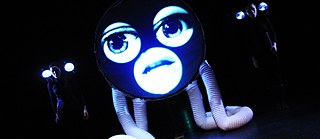German Season | Interview
Retrofuturisten

Retrofuturisten discover creative energy in Yogyakarta
You met Papermoon twice before entering your first working phase together in Yogyakarta in late June. What were your expectations?
We learned about the way the art scene is working in Indonesia, and particularly in Yogyakarta, which seems to be a cultural center of Java. Since we had already started working with the students from Berlin who are also taking part in the co-production we were really curious about how the ideas fit into our story, which we will continue to work on with Papermoon. Besides getting a better idea of the spirit of Yogyakarta by visiting some cultural and historical places in the city, we wanted to take part in the daily working life of the group. Working side by side allowed us to get in touch more deeply and share experiences and ideas with one another.
Could you tell us more about the concept of the co-production and the meaning of its theme “Borders”?
At the beginning we figured out a theme that inspired both parties. The theme “borders” is strongly connected to the human being. We discussed and are constantly thinking about the di.erent perspectives and meanings of the topic: its cultural, philosophical,
religious and social meaning. All of this was explored within the working phase. Based on a tale that was created together by Papermoon and Retrofuturisten, we then began to create di.erent forms of puppets.
An interesting part of the process is also to build a stage and use material that can be easily transported on a plane. In a 3-week workshop with students of the Ernst Busch School in Berlin, we explored the field of live animation by using mini projectors and Isadora technology to work with projections and little pop up stu.. This video art and pop up idea is directly connected to the storyline and main topic because the characters actually are trying to overcome their borders, whether it’s an inner or a concrete outer one.
What have you learned from one another so far?
To see how the Papermoon puppet theater built up a big community was really interesting and inspiring for us. Daily life and unannounced guests, for instance, are not disturbing their work but inspiring them. It was also good to see their open-minded exchange with other groups and artists because we are trying to do the same in Berlin: sharing experiences, building up networks, so it was more about conformation of our thoughts and seeing that we share the same visions. Papermoon also connects with other groups without any competition, with no fear of losing its unique look.
We visited two rehearsals of the production Mwathirika, where the spirit of the group was very visible: they were working on a festival version and every member of the group felt responsible for the show. This is very important in our way of working and creating art, too. So we noticed that we share a similar mindset, which is a good base to start the creative process together.
What were your first impressions of Yogyakarta? How does it compare to Berlin in terms of creative energy?
Yogyakarta seems to be a city full of art and culture, just like Berlin, but in a very different way. The art in Yogyakarta is locally concentrated; you know other artists and try to build relationships. There are many meeting points for artists while it is often hard to get an overview and be aware of new things in the extremely broad field of Berlin. In Yogyakarta, the networking between artists and the people in general is really amazing in its intensity – it was something new for us. The life in Yogyakarta seems to
be built on communities while Berlin is a city full of lone fighters. But within the art scene there‘s an increasing wish to connect more and more and encourage exchange between different art forms. So we actually can learn a lot of the networking between artists in Yogyakarta.
This interview was first published on the German Season/Retrofuturisten